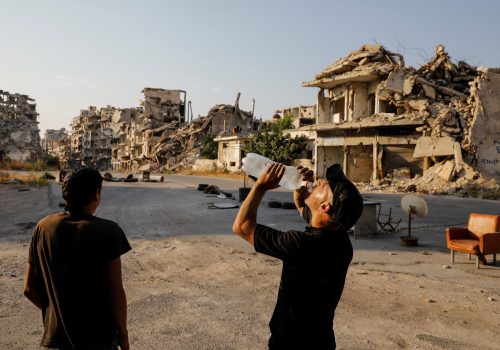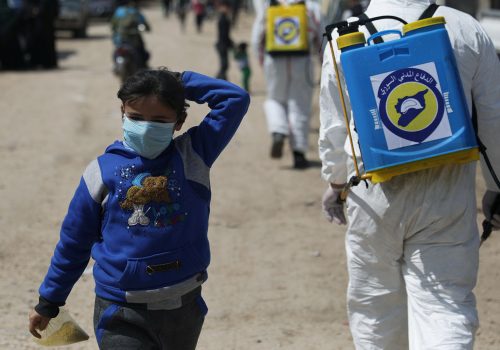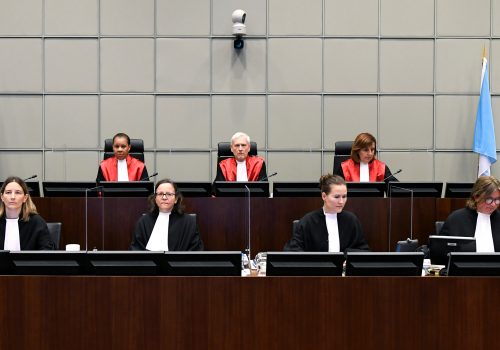Reliable no more? The current state of the Syrian armed forces
Throughout the past nine years of conflict, the Syrian military has been instrumental in ensuring the survival of the Bashar al-Assad regime—not because of its performance on the battlefield, but rather due to its consistent loyalty. Unlike other state militaries that faced regime challenges by the 2011 Arab Spring uprisings, the Syrian armed forces maintained institutional loyalty. Since the Assad family took power in the 1970s, the military underwent a structural transformation that, through control mechanisms and the Alawite minority’s hegemonic position, ensured force loyalty and upheld the military’s central role in the durability of Syria’s authoritarian regime.
However, the current conflict has truly impacted the configuration of the Assad regime as well as the structure and orientation of its military institution, putting the latter’s loyalty in question. Today’s Syrian armed forces are fragmented, decision-making is contested and increasingly decentralized, and the circle of loyalty has widened in an unprecedented manner. Furthermore, a multiplication of security actors and entrenched foreign involvement have only complicated the Syrian security and defense sector’s precarious condition, rendering civil-military relations less predictable and more vulnerable to regime challenges.
The pre-2011 Syrian military
Before discussing the changes, one ought to understand the Assad regime’s pre-2011 military force. When Hafez al-Assad took power in 1970, Syria’s civil-military relations were already at an acute degree of imbalance, where the military had a strong political orientation and a magnitude of authority. When building his regime, Assad was able to end the military’s notorious business in instigating regime change via coup d’états. But he did so not by ending its political role, but by institutionalizing it so that it formed the backbone of the regime’s power structure. Thus, the armed forces underwent a drastic transformation under Hafez, changing its character from a historically regime-challenging force into a pillar of regime security. The military’s role germinated to support Assad’s Baathist rule and secure his family’s tight control over the state’s power structures.
To rearrange the military to befit his regime’s objectives, Hafez significantly expanded its size. The total number of active armed personnel grew by around 162 percent in the first ten years of his rule and by around 264 percent upon his death in 2000, according to estimates compiled by the International Institute of Strategic Studies. Assad also infused a parallel chain of command and imposed overlapping mandates and institutional redundancy on key military formations. In this way, the various organs of the regime’s coercive apparatus were designed with several layers of allegiance to compete and conjoin for regime survival.
Additionally, and arguably most importantly, Assad took advantage of the deeply divided condition of Syrian society. He elevated the number and role of the Alawites—the minority community to which the Assad family’s social and religious roots belong. Hafez—and later Bashar al-Assad—recognized the impact ethnic inclusion in the military could have on the loyalty among its ranks. As a result, the Alawite were disproportionately represented in the armed forces and the wider security sector. While this posed a legitimacy problem with regards to the public’s perception of the military’s national defense character, it also produced an institutionalized cycle of fear and distrust in Syrian society that not only provided the Assad regime with a loyal and hegemonized group in the military, but also made the Alawites dependent on the regime in a hostile and deeply divided country. As the Assad regime consolidated power, the military’s chief mission became clear: securing regime continuity above all national defense and security considerations.
Today’s Syrian military: Fragmentation and foreign penetration
Prior to 2011, the Assad regime faced formidable domestic challenges—such as the Muslim Brotherhood rebellion in Hama in 1982 and Rifat Assad’s failed coup attempt in 1984—in which the military played a central role in repelling. However, none were like the ongoing challenge that started in 2011, which, forced Bashar to rearrange and surrender some sovereignty over key power structures to maintain regime survival. While the structures that Hafez designed proved useful in standing against widespread public dissatisfaction in the first few years of the conflict, the increased capability of major rebel formations and the consequent battlefield ineffectiveness of Assad’s military prompted the inadvertent expansion of local security forces and import of foreign actors, such as Russia and Iran. Today, this has proven to be a tumorous growth in the Syrian military institution, causing loyalty dilemmas, diversification in funding sources, regional and ideological segmentation, parallel decision-making processes, and dependence on foreign patrons.
To adapt to evolving conflict dynamics, a kaleidoscope of unregulated militias and paramilitary forces with various funding sources and scopes of involvement emerged—particularly after 2013 with Legislative Decree 55—to supplement the Syrian army. While some militias, such as the Local Defense Forces, were institutionalized in the regular army as an auxiliary force, many pro-regime militias remain in a grey legal and operational area contingent on what the post-war structure will look like. Some militias reportedly receive funding from shady pro-regime businessmen, while others are funded exclusively by foreign actors, such as Iran and Russia. As some of these militias took domestic security roles, their recruitment patterns became segmented along regional, religious, and ideological lines, which can indicate growing localized autonomies and a widened circle of loyalty, as well as security and defense incoherence.
This hybrid structure of the Syrian security sector forced de-centralization on military decision-making in a system that had long been ultra-centralized. Armed pro-regime militias have influence to affect key defense decisions, including resource distribution, mobilization, and deployment. Clashes among these militias have been reported throughout the Syrian conflict and across different frontlines. Moreover, the state-militia relationship is precarious, where militias have a patronage relationship with competing organs of the military-intelligence community. In light of engrained corruption and transactional interests, this can lead to conflicts within the military institution.
On the other hand, Russia and Iran have invested high stakes in the Syrian army and the wider security sector and currently exercise considerable influence over the military. While Moscow and Tehran improved the Syrian army’s battlefield effectiveness and reversed its territorial losses, such victory came at a high price as the Assad regime’s sole monopoly over the military decreased. Both foreign powers are increasingly involved in even the appointment of senior officers, unit commanders, and the leadership of intelligence commands. They also worked—sometimes competitively—towards institutionalizing and integrating the many militias into the Syrian army’s command structure. Decision-making with regards to operational strategies is almost completely controlled by Russia and, to a lesser extent, Iran; Syrian army units associated with either foreign power increasingly take part in battles planned and conducted by their foreign ally’s troops or advisors. As a result, it can be assumed that Moscow also has influence over the allocation of resources within the military and can award loyal units and officers.
The other key aspect of the Syrian military is the presence and loyalty of the Alawites. While the Alawites’ hegemonic occupancy of the army heightened after 2011 due to Sunni defections, the community’s relationship with the military institution—and the regime by extension—changed. Their military support of the Assad regime came at an immense cost; they disproportionally lost much of their youth on the battlefield while their community continues to be hurt by the growing deterioration of living conditions. As the Alawites sacrifice for a regime that is unable to provide them with basic necessitates, their circle of loyalty is widening to include emerging notables who are substituting risky military service with safer militia membership and state services with local charities.
Perhaps the recent crackdown on businessman and regime financier Rami Makhlouf—seizing his assets, disbanding militias he financed, and shutting down his charity—can attest to his growing influence among the Alawites and the increasing vulnerability Assad is feeling with regards to his community’s support. However, the Alawites remain entrapped in the cycle of fear that the Assad regime created, which has isolated the minority community from the rest of Syrian society. This has made Assad—for the time being at least—a necessity for the community’s survival.
While the Syrian military played a key role in securing the Assad regime’s survival, the structures that were once designed to keep its forces loyal have gradually shattered in the past nine years. Although the forced de-centralization, multiplication of security actors, and foreign involvement saved the Syrian regime from military defeat, Assad measures the quality of his forces by their consistent loyalty and willingness to use force for his regime’s defense, not by their performance on the battlefield. While a coup against Bashar al-Assad or a collapse of his rule are unlikely, he no longer has the reliability that existed in the past fifty years.
Abdulrahman al-Masri is an independent analyst, focusing on politics and security issues in the Middle East. Follow him on Twitter: @AbdulrhmanMasri.
Image: Syrian President Bashar al Assad visits Syrian army troops in war-torn northwestern Idlib province, Syria, in this handout released by SANA on October 22, 2019. SANA/Handout via REUTERS



